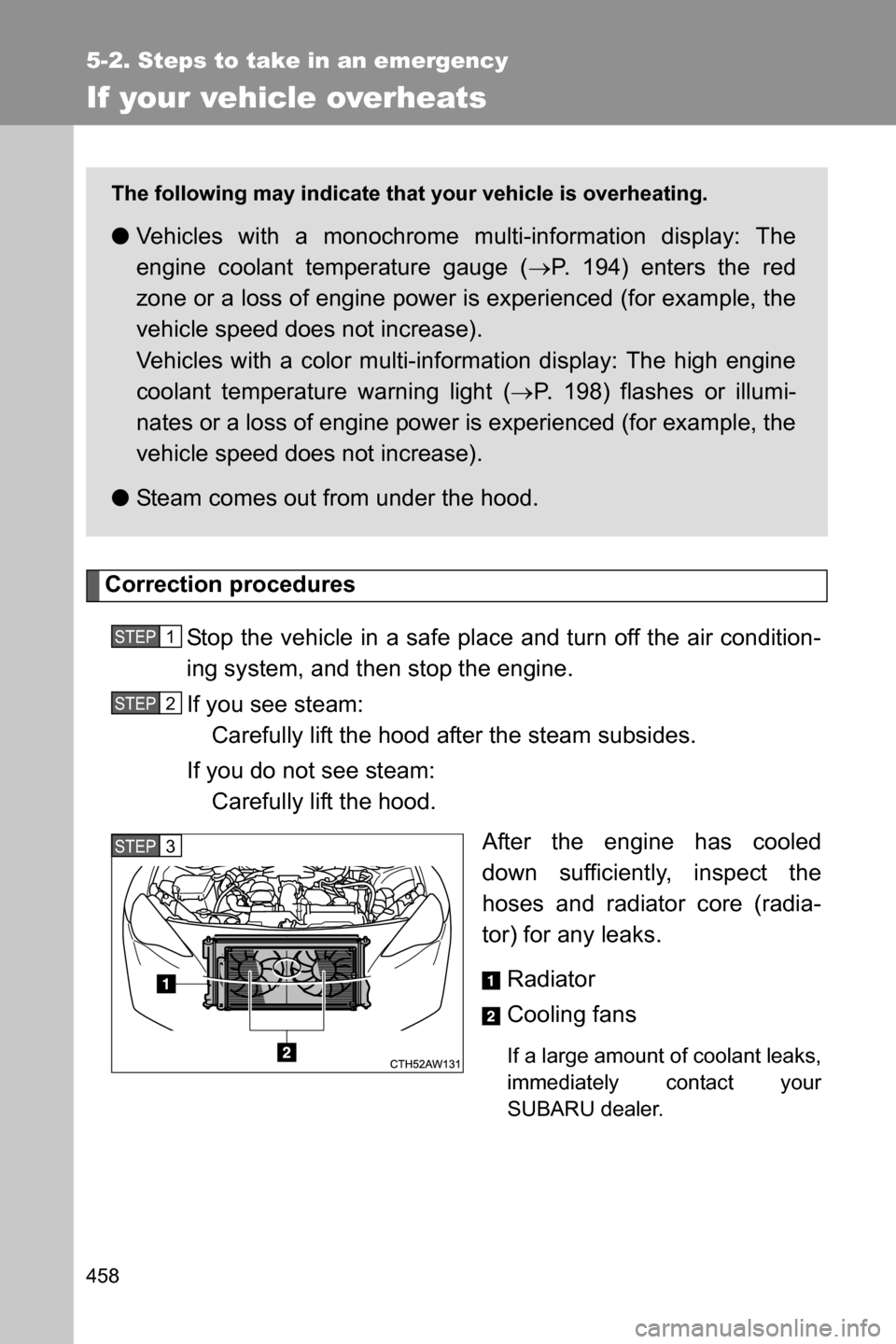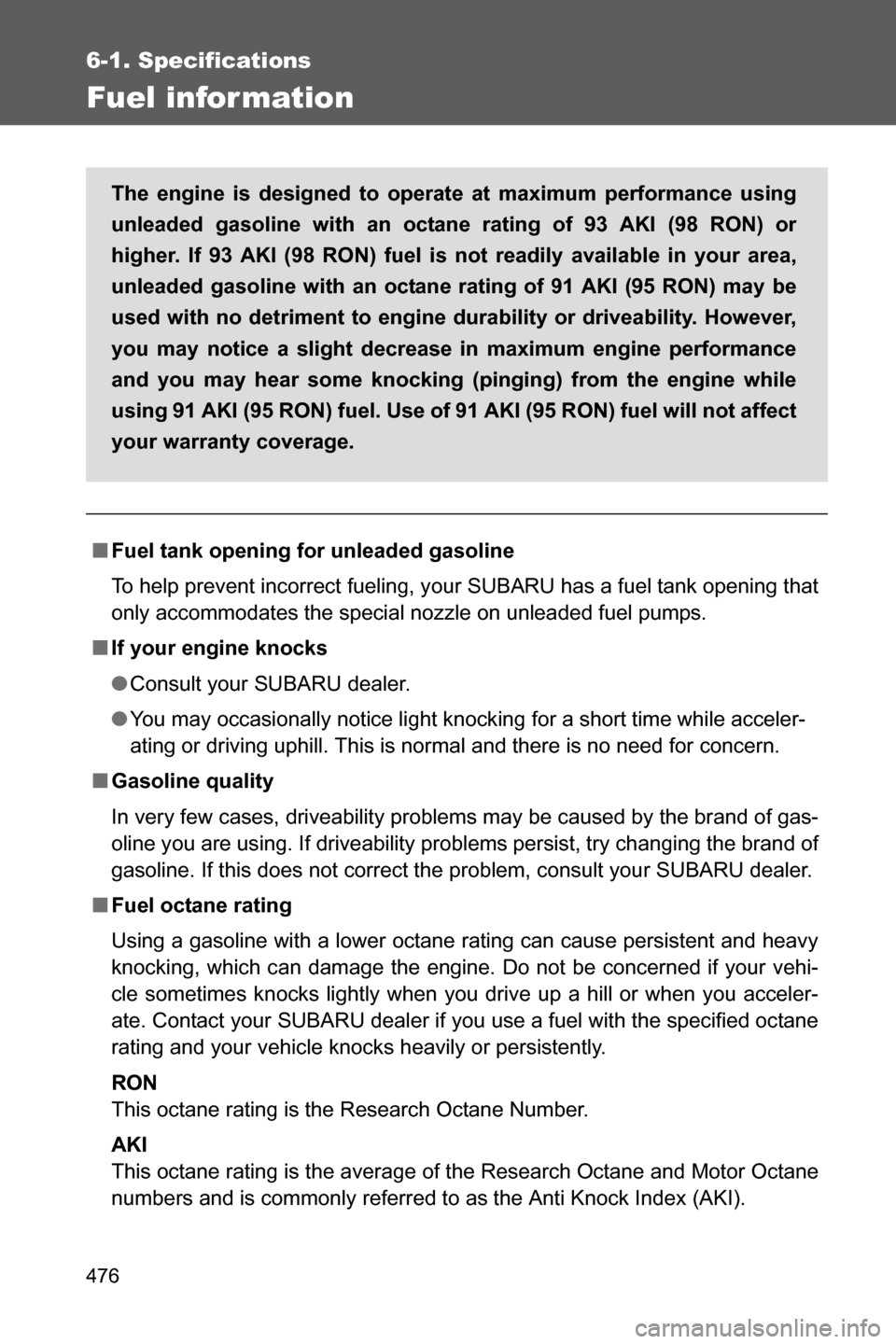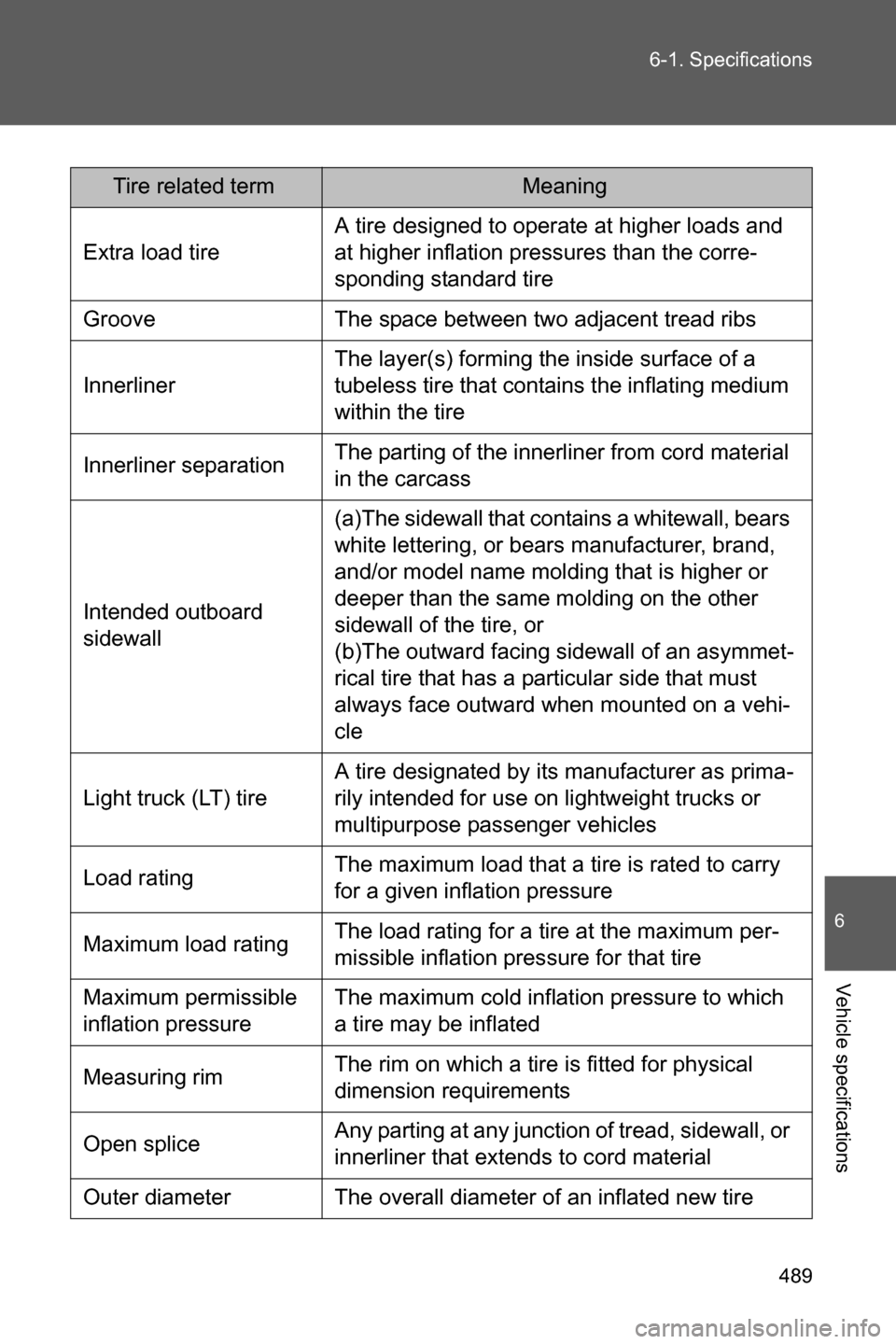Page 458 of 540

456 5-2. Steps to take in an emergency
WARNING
■Avoiding battery fires or explosions
Observe the following precautions to prevent accidentally igniting the flam-
mable gas that may be emitted from the battery.
●Make sure the jumper cable is connected to the correct terminal and that it
is not unintentionally in contact with any part other than the intended termi-
nal.
●Do not allow the jumper cables to come into contact with the “+” and “-” ter-
minals.
●Do not allow open flame or use matches, cigarette lighters or smoke near
the battery.
■Battery precautions
The battery contains poisonous and corrosive acidic electrolyte, while
related parts contain lead and lead compounds. Observe the following pre-
cautions when handling the battery.
●When working with the battery, always wear safety glasses and take care
not to allow any battery fluids (acid) to come into contact with skin, clothing
or the vehicle body.
●Do not lean over the battery.
●In the event that battery fluid comes into contact with the skin or eyes,
immediately wash the affected area with water and seek medical attention.
Place a wet sponge or cloth over the affected area until medical attention
can be received.
●Always wash your hands after handling the battery support, terminals, and
other battery-related parts.
●Do not allow children near the battery.
■To prevent damage to the vehicle
Do not pull- or push-start the vehicle as the three-way catalytic converter
may overheat and become a fire hazard.
Page 460 of 540

458
5-2. Steps to take in an emergency
If your vehicle overheats
Correction procedures
Stop the vehicle in a safe place and turn off the air condition-
ing system, and then stop the engine.
If you see steam:
Carefully lift the hood after the steam subsides.
If you do not see steam:
Carefully lift the hood.
After the engine has cooled
down sufficiently, inspect the
hoses and radiator core (radia-
tor) for any leaks.
Radiator
Cooling fans
If a large amount of coolant leaks,
immediately contact your
SUBARU dealer.
The following may indicate that your vehicle is overheating.
●Vehicles with a monochrome multi-information display: The
engine coolant temperature gauge (�oP. 194) enters the red
zone or a loss of engine power is experienced (for example, the
vehicle speed does not increase).
Vehicles with a color multi-information display: The high engine
coolant temperature warning light (�oP. 198) flashes or illumi-
nates or a loss of engine power is experienced (for example, the
vehicle speed does not increase).
●Steam comes out from under the hood.
STEP 1
STEP 2
STEP 3
Page 477 of 540
475 6-1. Specifications
6
Vehicle specifications
Tires and wheels (for vehicles sold in Mexico)
Light bulbs
A: Wedge base bulbs (clear)
B: Double end bulbs
C: Wedge base bulbs (amber)
Tire size 215/45R17 87W
Tire inflation pressure
(Recommended cold tire
inflation pressure)Front
35 psi (240 kPa, 2.4 kgf/cm2 or bar)
Rear
35 psi (240 kPa, 2.4 kgf/cm
2 or bar)
Spare
35 psi (240 kPa, 2.4 kgf/cm
2 or bar)
Wheel size 17 �u 7 J
Wheel nut torque89 ft•lbf (120 N•m, 12.2 kgf•m)
Light BulbsBulb No.WTyp e
ExteriorFront side marker lights W3.8W 3.8 A
License plate lights W5W 5 A
Back-up lights W16W 16 A
InteriorVanity lights (if equipped)�2B
Trunk light W5W 5 C
Interior light�10 B
Door courtesy lights
(if equipped)T10 5 C
Page 478 of 540

476
6-1. Specifications
Fuel infor mation
■Fuel tank opening for unleaded gasoline
To help prevent incorrect fueling, your SUBARU has a fuel tank opening that
only accommodates the special nozzle on unleaded fuel pumps.
■If your engine knocks
●Consult your SUBARU dealer.
●You may occasionally notice light knocking for a short time while acceler-
ating or driving uphill. This is normal and there is no need for concern.
■Gasoline quality
In very few cases, driveability problems may be caused by the brand of gas-
oline you are using. If driveability problems persist, try changing the brand of
gasoline. If this does not correct the problem, consult your SUBARU dealer.
■Fuel octane rating
Using a gasoline with a lower octane rating can cause persistent and heavy
knocking, which can damage the engine. Do not be concerned if your vehi-
cle sometimes knocks lightly when you drive up a hill or when you acceler-
ate. Contact your SUBARU dealer if you use a fuel with the specified octane
rating and your vehicle knocks heavily or persistently.
RON
This octane rating is the Research Octane Number.
AKI
This octane rating is the average of the Research Octane and Motor Octane
numbers and is commonly referred to as the Anti Knock Index (AKI). The engine is designed to operate at maximum performance using
unleaded gasoline with an octane rating of 93 AKI (98 RON) or
higher. If 93 AKI (98 RON) fuel is not readily available in your area,
unleaded gasoline with an octane rating of 91 AKI (95 RON) may be
used with no detriment to engine durability or driveability. However,
you may notice a slight decrease in maximum engine performance
and you may hear some knocking (pinging) from the engine while
using 91 AKI (95 RON) fuel. Use of 91 AKI (95 RON) fuel will not affect
your warranty coverage.
Page 491 of 540

489 6-1. Specifications
6
Vehicle specifications
Tire related termMeaning
Extra load tireA tire designed to operate at higher loads and
at higher inflation pressures than the corre-
sponding standard tire
Groove The space between two adjacent tread ribs
InnerlinerThe layer(s) forming the inside surface of a
tubeless tire that contains the inflating medium
within the tire
Innerliner separationThe parting of the innerliner from cord material
in the carcass
Intended outboard
sidewall(a)The sidewall that contains a whitewall, bears
white lettering, or bears manufacturer, brand,
and/or model name molding that is higher or
deeper than the same molding on the other
sidewall of the tire, or
(b)The outward facing sidewall of an asymmet-
rical tire that has a particular side that must
always face outward when mounted on a vehi-
cle
Light truck (LT) tireA tire designated by its manufacturer as prima-
rily intended for use on lightweight trucks or
multipurpose passenger vehicles
Load ratingThe maximum load that a tire is rated to carry
for a given inflation pressure
Maximum load ratingThe load rating for a tire at the maximum per-
missible inflation pressure for that tire
Maximum permissible
inflation pressureThe maximum cold inflation pressure to which
a tire may be inflated
Measuring rimThe rim on which a tire is fitted for physical
dimension requirements
Open spliceAny parting at any junction of tread, sidewall, or
innerliner that extends to cord material
Outer diameter The overall diameter of an inflated new tire
Page 497 of 540
495 6-2. Customization
6
Vehicle specifications
Automatic
light control
system
(�oP. 228)Light sensor sensitivity ±0% -40% to +40%
Time elapsed before
headlights automati-
cally turn off after doors
are closed30 seconds0 second
60 seconds
90 seconds
Rear window
defogger
(
�oP. 292)Time elapsed before
the rear window defog-
ger turn off (vehicles
with automatic air con-
ditioning system)15 minutes Continue
Illumination
(
�oP. 296)Time elapsed before
lights turn off15 seconds7.5 seconds
30 seconds
Operation when the
doors are unlockedOn Off
Operation after the
engine switch is turned
offOn Off
Interior light illumination
upon approach (vehi-
cles with a keyless
access with push but-
ton start system)On Off
Interior light illumination On Off
ItemFunctionDefault settingCustomized
setting
Page 526 of 540
524
Abbreviation list
Abbreviation/Acronym list
ABBREVIATIONSMEANING
ABS Anti-lock Brake System
ACC Accessory
ALR Automatic Locking Retractor
CRS Child Restraint System
DISP Display
ECU Electronic Control Unit
EDR Event Data Recorder
ELR Emergency Locking Retractor
GAWR Gross Axle Weight Ratings
GVWR Gross Vehicle Weight Rating
I/M Emission inspection and maintenance
LATCH Lower Anchors and Tethers for Children
LED Light Emitting Diode
LSD Limited Slip Differential
M + S Mud and Snow
MMT Methylcyclopentadienyl Manganese Tricarbonyl
MTBE Methyl Tertiary Butyl Ether
OBD On Board Diagnostics
SRS Supplemental Restraint System
TIN Tire Identification Number
TPMS Tire Pressure Monitoring System
TRAC Traction Control
VIN Vehicle Identification Number
VSC Vehicle Stability Control
Page 527 of 540

525
Alphabetical index
Alphabetical index
A/C .................................... 276, 283
ABS........................................... 251
Access key
If the access key does
not operate properly........... 449
Air conditioning filter.............. 364
Air conditioning system
Air conditioning filter ............. 364
Automatic air conditioning
system................................ 283
Manual air conditioning
system................................ 276
Airbags
Airbag operating
conditions................... 106, 114
Airbag precautions for
your child............................ 123
Airbag warning light .............. 404
Curtain airbag
operating conditions........... 114
Curtain airbag
precautions ........................ 123
Front passenger occupant
detection system ................ 129
General airbag
precautions ........................ 123
Locations of airbags ............... 91
Modification and
disposal of airbags ............. 126
Proper driving
posture ......................... 89, 123
Side airbag operating
conditions........................... 114
Side airbag
precautions ........................ 123
Side and curtain airbags
operating conditions........... 114
Side and curtain airbags
precautions ........................ 123
SRS airbag instructions
for Canadian owners .......... 502
SRS airbags ........................... 91Alarm ...........................................85
Anti-lock brake system............251
Audio input ...............................294
Audio system
Audio input ............................294
AUX port................................294
iPod .......................................294
Portable music player............294
USB memory .........................294
USB port................................294
Automatic air conditioning
system ....................................283
Automatic headlight
leveling system ......................231
Automatic light
control system .......................228
Automatic transmission
Automatic transmission .........181
If the select lever cannot be
shifted from P......................447
Manual mode ........................184
Mode select switch ................183
Paddle shift levers .................184
AUX port ...................................294
Back-up lights
Replacing light bulbs .............380
Wattage .................................475
Battery
Checking ...............................344
If the vehicle has a
discharged battery ..............453
Preparing and checking
before winter .......................268
Bottle holders ...........................300
Brake
Fluid ......................................342
Parking brake ........................192
Brake assist..............................251
Break-in tips .............................157A
B